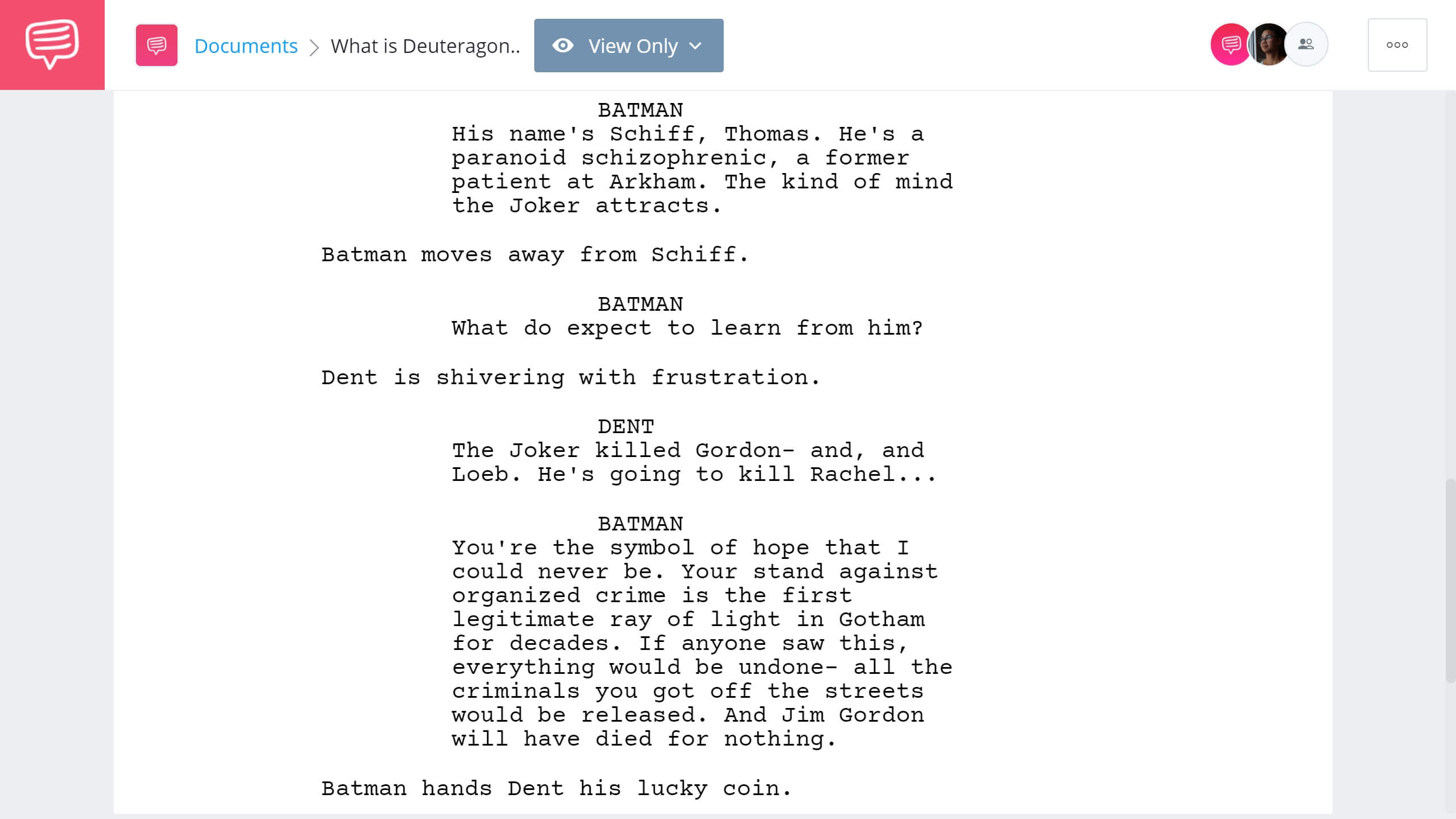You’ve heard of a protagonist and an antagonist. And now you can really knock the socks off your screenwriting buddies by discussing how your script’s deuteragonist impacts the plot. But what is a deuteragonist and how can you make sure yours serves a vital function in your story. You’re the hero of your filmmaking journey while StudioBinder is the sidekick, so let’s dive into this archetype.
DEUTERAGONIST MEANING
How to define deuteragonist
Just because a character is a deuteragonist doesn’t mean they have to play second fiddle to the protagonist. Some characters, like Captain Jack Sparrow, are technically deuteragonists but end up stealing the show. But what does deuteragonist mean exactly?
DEUTERAGONIST DEFINITION
What is a deuteragonist?
A deuteragonist is the second most important character in a story. This person is also known as the “secondary main character.” While the protagonist gives us our primary point of view of the story, the deuteragonist often provides a different, but often similar, outlook.
Deuteragonist Examples:
- Doc Brown in Back to the Future
- Furiosa in Mad Max: Fury Road
- Ellis Redding in The Shawshank Redemption
- Elsa in Frozen
- M in Skyfall
DEUTERAGONIST DEFINITION AND EXAMPLES
What is a deuteragonist’s purpose?
A secondary protagonist can take on a different role in a story. Sometimes they support the main character. Other times, they oppose them. In many cases, they go back and forth within a single story.
Ultimately, a deuteragonist should help the main character complete their character arc. The protagonist may adopt some of the deuteragonist’s traits, such as an anti-hero learning to be more compassionate. Or the deuteragonist can show the hero a different way to attain a goal.
We’ve imported The Dark Knight script PDF into StudioBinder’s screenwriting software. Through Batman’s relationship with Harvey Dent, this movie’s deuteragonist, we can gain a better sense of how a secondary character should ideally fit within a story.
Read The Dark Knight Screenplay • Harvey Flips a Coin
Batman’s goal in the movie is to defeat Joker and make Gotham safer. Batman accomplishes this through illegal means as a vigilante. But Harvey Dent presents a legitimate way to rid Gotham of far-reaching crime. Batman understands that Harvey ultimately needs to lead the way for Gotham’s future.
This reaches a head at the movie’s finale. Harvey Dent becomes Two-Face and goes on a murderous rampage. Batman, by seeing how good Dent once was, decides to take the blame so that the city can pass legislation to fight crime on a more massive scale.
The deuteragonist may not get as much screen time as the protagonist. But their journey should influence the main character’s journey and play a significant role in the finale. And there are three distinct roles a deuteragonist can take within a story.
WHAT DOES DEUTERAGONIST MEAN?
Deuteragonist #1: The Sidekick
This is the most common type of deuteragonist. The sidekick is the best friend or assistant. They’re there to offer insight, function as a gentle combatant, or offer comic relief.
One of the most famous sidekicks within literature and film is Samwise Gamgee from The Lord of the Rings series. Over the course of the journey, Frodo gradually becomes corrupted by the One Ring. His descent is only compounded once Gollum joins their crew as a tritagonist.
But Samwise remains an unwavering force of optimism and perseverance. In one of the most moving moments of the entire trilogy, Samwise carries Frodo to the top of Mount Doom.
Sidekicks can be an additional voice of reason, such as Watson in Sherlock Holmes or Jiminy Cricket in Pinocchio. The sidekick can provide a missing piece of the puzzle the protagonist needs to have to feel complete.
This is what happens in Hot Fuzz when Angel learns to relax more after becoming friends with Danny.
When writing your own sidekick, remember to bear in mind their relationship. If the protagonist and deuteragonist are best friends, they have to be similar enough to actually be friends but different enough so that one or both characters can have growth. If the sidekick is wildly different from the main character, then consider what scenarios would bring those two together.
Ultimately, the sidekick needs to bring something to the table you don’t get with the protagonist alone.
DEUTERAGONIST EXAMPLES
Deuteragonist #2: The Love Interest
Sometimes, the two main characters are in love. Rose is the protagonist in Titanic. But through her relationship with Jack, the deuteragonist, she learns what she really wants out of life, and it isn’t what high society expects from her. In this interest, the love interest helps the protagonist achieve their goal.
This can also be seen in La La Land, which you can download a script PDF here. Sebastian is the protagonist. We follow his journey as he becomes a jazz pianist. And that wouldn’t be possible without Mia as his love interest.
Mia has her own character arc as she struggles to become a famous film actress. Through their relationship, they both attain their dreams, which wouldn’t be possible if it wasn’t for the other person.
They may not end up together by the end of the film, but getting together wasn’t the journey they were on.
Love interests take many shapes. They can be star-crossed lovers or have a love/hate relationship that blossoms into pure love.
When writing a love interest who functions as a deuteragonist, you want to make sure both people have their own autonomy. The love interest shouldn’t just be a pretty face. The audience should understand why the main character would want to be with this person. And the love interest should have some goals of their own.
Related Posts
HOW TO PRONOUNCE DEUTERAGONIST
Deuteragonist #3: The Antagonist
Yes, a character can serve a dual role within a screenplay and be both a deuteragonist and antagonist. In some scripts, you may discover that the villain gets the second-most attention, next to the hero.
Some of the best antagonists of all time, such as Hannibal Lecter in The Silence of the Lambs, also function as deuteragonists.
Not all villains are necessarily deuteragonists. However, you can create more compelling antagonists if you devote time to fleshing out their backstory. When the villain is tied so closely to the hero, they become more interesting.
WHAT IS A DEUTERAGONIST?
Can a Film Have Two Deuteragonists?
You shouldn’t feel the need to limit yourself to one deuteragonist. Multiple characters can absolutely occupy the “second-best” spot.
This can most clearly be seen in Pirates of the Caribbean: The Curse of the Black Pearl. Will Turner is the protagonist of the story while Elizabeth Swann is a deuteragonist. However, due to her relationship with Will, she’s a “love interest” variety of deuteragonist. Meanwhile, Captain Jack Sparrow is also a deuteragonist but in more of a “sidekick” role to Will.
Both characters relate to Will in different ways. Barbossa and Norrington may be antagonists, but since they aren’t given as much screen time, they’re more tritagonist characters.
Don’t feel the need to limit yourself to one deuteragonist, one antagonist, or even one protagonist. If your story benefits from stretching out the ensemble, then go for it!
WRITING A DEUTERAGONIST
How to Write a Deuteragonist
When writing your screenplay, everything needs to be in service of the story. What are your protagonist’s goals? What themes do you want to express?
Follow the main arc
The deuteragonist should complement the hero’s journey. Perhaps the deuteragonist brings something valuable to the final fight. Or maybe the secondary character offers a point of view the protagonist would not have considered ordinarily.
Hermione Granger from the Harry Potter series is an effective deuteragonist because she brings the book smarts both Harry and Ron severely lack. She helps Harry achieve his goals throughout the film series, but she never overshadows Harry’s arc.
She has a great deal of character development as she becomes a more powerful witch, but the focus of the story always lies squarely with Harry.
Don’t get carried away
You don’t want the deuteragonist’s story to overshadow that of the protagonist’s. This is what happened with the Pirates of the Caribbean series. Jack Sparrow makes a great side character in the first movie. But in the sequels, he becomes the lead while Will and Elizabeth take a backseat. He’s just not as compelling when all of the focus goes on him.
If you find that your movie’s B-story is more intriguing than the A-story, then you should ask yourself which one really needs to be told. Every character should have a role in your story. And your deuteragonist needs to bring something to the table the protagonist can learn from.
Related Posts
UP NEXT
Protagonist Examples
A deuteragonist should fill in some of the blanks we get with the protagonist. But how should you write a compelling hero? By looking at some stellar protagonists, such as Ripley from Aliens and T’Challa from Black Panther, you can see how to write a good lead for your screenplay. And once you know how to write a great protagonist, you’re better situated to have a compelling deuteragonist, too.

